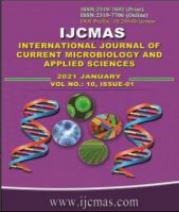


 National Academy of Agricultural Sciences (NAAS)
National Academy of Agricultural Sciences (NAAS)

|
PRINT ISSN : 2319-7692
Online ISSN : 2319-7706 Issues : 12 per year Publisher : Excellent Publishers Email : editorijcmas@gmail.com / submit@ijcmas.com Editor-in-chief: Dr.M.Prakash Index Copernicus ICV 2018: 95.39 NAAS RATING 2020: 5.38 |
Pulses are referred to as poor man’s meat, as they are major sources of protein and compliment the stable cereals in the diet with essential nutrients. Field pea is an annual cool season grain legume or pulse crop and majorly grown in rabi season and third most popular rabi pulse of India after chickpea and lentil. The study was conducted to determine the “Effect of different organic and inorganic seed priming method on growth, yield and quality parameters of field pea (Pisum sativum L.)” The experiment was carried out at Field Experimentation Centre and Seed Testing Laboratory of the Department of Genetics and Plant Breeding, Sam Higginbottom University of Agriculture, Technology & Sciences, Prayagraj (UP) during Rabi-2019. The experiment was laid out in Randomized Blocked Design for field studiesand Completely Randomized design for lab studies and comprised of 13 treatments and 3 replications. The treatments were T0(Control), T1(Distilled water), T2 (Tulasi leaf extract@ 5%), T3 (Pongamia Leaf Extract@ 5%), T4(Curry Leaf Extract@5%), T5 (Moringa Leaf Extract@5%),T6 (Neem Leaf Extract @ 5%), T7(KH2PO4@ 1%), T8(KH2PO4@ 3%), T9(KN03 @ 1%) T10 (KN03 @ 3%), T11(GA3 100ppm), T12(PEG 6000 @20%) with a soaking duration of 12 hours. The results revealed that seeds primed with T10 (KN03 @ 3%) improved Germination%, Growth, yield and Seed quality Parameters followed by T6 (Neem Leaf Extract @ 5%) and the least performance was observed in T0 (control) when compared with other treatments. Hence, seed priming with (KN03 @3%) and Neem Leaf Extract @5% could be recommended for field pea as a pre-sowing seed treatment.
 |
 |
 |
 |
 |